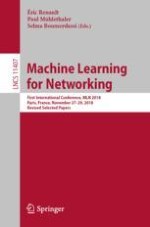2019 | OriginalPaper | Chapter
Towards a Better Compromise Between Shallow and Deep CNN for Binary Classification Problems of Unstructured Data
Author : Khadoudja Ghanem
Published in: Machine Learning for Networking
Publisher: Springer International Publishing
Activate our intelligent search to find suitable subject content or patents.
Select sections of text to find matching patents with Artificial Intelligence. powered by
Select sections of text to find additional relevant content using AI-assisted search. powered by
